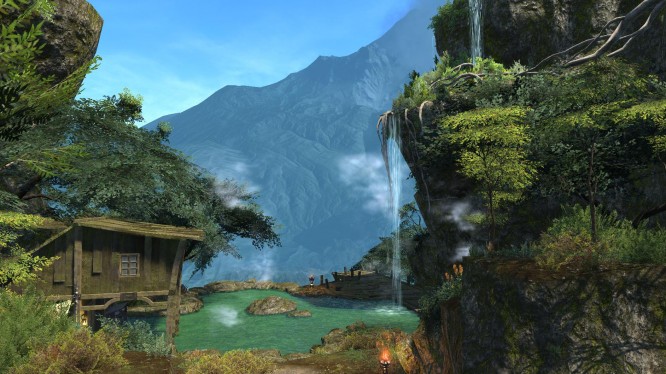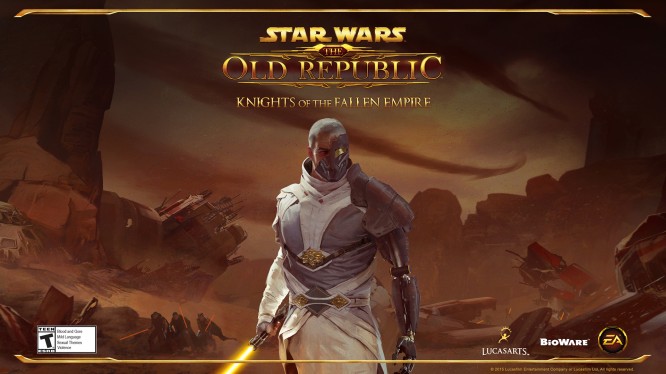

Since the beginning of time humans have viewed reality through the lens of a duality: life and death, good versus evil, yin and yang. EVE Online is host to its own duality, Red vs Blue; two alliances locked in eternal combat like mythological deities. For years the alliances have feuded, but the catalyst for this was never sovereignty, personal disputes, or whatever other reasons that cause billions of ISK to evaporate every day in New Eden. Instead, this endless war is waged for one thing: fun.
“The aim of the RvB community is just constant combat,” Mangala Solaris told me during an interview. “You basically log in, undock—be it alone be it in a fleet—and there is stuff for you to kill from the other alliance in the community.”
Mangala has been the CEO of The Red Federation, the yin in Red vs Blue, for just over four months. It doesn’t take long before you can feel his enthusiasm and conviction for the important niche that Red vs Blue serves.
“Just like you’d log into Halo for a good deathmatch,” he told me. “Our mission is to give pilots access to quick, fun PVP, and if they learn something along the way, we consider that bonus.”
The analog to Halo isn’t made lightly either, considering both share a mutual nod to the tradition in first-person shooters to distinguish teams by the colors red and blue. But the reference extends far beyond the name; it is a philosophy that governs how the alliance operates.
“Once you do that, dock up, get a new ship, rinse and repeat.”

In an online world built upon the narrative of causality and the power of player agency, Red vs Blue stands in stark contrast. It isn’t about forging a story or creating a legacy; it is about getting players to experience a side of EVE that many have never experienced.
The alliances are extraordinarily welcoming to new players, but their approach to giving their pilots their first taste of blood is very sink-or-swim.
“It’s very much learning by doing—which is the best way to learn in the RvB environment,” Mangala explained, but is quick to add: “Not necessarily in the wider environment of EVE, but in the RvB environment, it being very forgiving and relatively cheap and easy on most people’s wallets in terms of ISK that you lose, and the programs that we have to support that; we do encourage people just join fleet and if you have any questions, speak up.”
“There is always people willing to give you advice.”
That said, Mangala informed me that he and ShenanigansBus, CEO of the Blue Republic—the yang, have identified a need for a more regimented training process aimed at instructing newer pilots.
“It’s something that we’re currently building up at the moment. We’ve basically nicknamed our whole aspect of RvB’s learning program as RvB Miramar,” Mangala explained, before jumping in to dissuade me from associating it with the movie Top Gun and it’s bawdy volleyball scene. But, as even Mangala is forced to admit, “Tom Cruise goes a long way.”
Learning is important, but it will always take a back seat to the thrill of constant combat, something that RvB has proven adept at fabricating. Players can either join the Red Federation or the Blue Republic, two corporations within two separate alliances who are continually locked in an official war. The two alliances are based within high-security space, specifically near the heart of New Eden, the massive trade hub of Jita. New recruits can join either alliance, even swapping sides if they need to, with the goal of getting into fights on a nearly constant basis.
In a sense, Red vs Blue lacks a lot of the structure imposed by more traditional corporations in EVE Online. Recruitment is as streamlined as possible, players can submit an application and join as soon as it is processed. In a game where corporations seem to be finding more and more ways to filter their candidates, the process seems refreshingly simple. Once a pilot has been recruited their mission is simple: find something to kill. In pursuit of that noble goal, the alliances lack any sort of regimented structure towards engagements. Pilots are encouraged to form their own fleets and find their own fights, and those who step up to lead them are encouraged and rewarded for their willingness.
“Anyone can do it. You can join RvB, day one,” Mangala said, “you can think, ‘I’ve got some people skills, I’ve got a working mic, and I possibly know how to shoot the ships in front of me — I’ll get people to come follow me.’”
“Boom. You do that, you’re a hero.”
“People coalesce around content; [fleet commanders] provide the content for pilots in EVE. So, anyone who steps up to FC will always have people join their fleet and follow them regardless of the outcome,” Mangala said. “People will join a FC’s fleet whether they’re going to win or they’re going to lose.”

Initiatives were created to reward such bold individuals, and those who step up to lead will be rewarded for fulfilling generous requirements, chiefly in the form of loyalty points, which pilots can then redeem for more powerful ships.
It doesn’t stop there, however, as the alliance is proud to offer a staggering amount of programs designed to eliminate much of the burden of entropy that exists in New Eden. EVE is a unique game in the sense combat breeds loss, unlike many MMORPGs that exist free from the constraints of supply and demand. For a new player, combat can not only be intimidating due to the endless well of nuance associated with mastering it, but because of the inherent cost of physically losing ships and having to spend money to replace them. In times passed, Mangala explained that pilots would frequently leave RvB for a period of time so that they could make money without the threat of combat just so that they could continue to afford losing ships. Now, both alliances offer a plethora of programs aimed to minimize that necessity and keep players’ crosshairs trained on the enemy, rather than elsewhere.
The fitted ship program is one such initiative. Growing from a simple offering of fitted frigates for players to buy via in-game contracts, the system has evolved into a fully fledged website detailing which ships are currently available for contract, the modules and weapons fitted, what roles they can fill in a fleet, and the ability to place custom and backorders to be delivered via contract. Mangala is proud of it and the volunteers who made it happen.
“It is beautiful.”
But this massive infrastructure incurs a massive cost, something that RvB has adeptly handled without the need for donations that many such programs would rely on. Instead, Mangala informed me of the staggering network of Player Owned Customs Offices (POCOs) that RvB owns and maintains around their home in the Forge. These POCOs allow the alliances to harvest the resources on the planets they orbit, which RvB uses to fund all of their initiatives, wars, special events, and more.
Of course, maintaining such a dominating presence in New Eden comes with its own perils, and corporations have lined up looking to bloody the twin alliances and claim some of their pie for their own. A mistake that, more often than not, proves devastating..
“One time we had NOIR [declare war on] us, after the POCO shenanigans started, because they had a client that wanted the POCO we were going for,” Mangala told me. “They wouldn’t engage us because they weren’t paid to kill us, they were paid to take the POCO.”
“In the end I think they said to the client, ‘have you money back.’”

War is commonplace in Red vs Blue, but not always from the usual suspects. The ongoing conflict between the two primary alliances is often put aside in favor of a unified attack on other targets, including massive Russian alliances, null-sec alliances, and even EVE University itself.
Another opportunity present for those within the community is the ability to join “Not Purple Shoot It” roams, which are fleets formed for the purpose of blowing up everything that isn’t designated purple (the colour that notes other fleet members). These fleets fly out weekly, carving a path through various high and low-security systems and leaving carnage in their wake.
When pilots aren’t shooting one another, or everything else, they are encouraged to partake in any activity that seems interesting.
“You can join RvB and we don’t care what you do as long as it doesn’t hurt or impinge the gameplay of a fellow RvBer.”
It’s a philosophy that gives pilots the freedom to find their own fun and simultaneously creates a casual corporate atmosphere. Pilots don’t need to join and fear the responsibility that can come from playing in many of EVE’s player corporations, nor feel an obligation to show up for various events.
As Mangala and I begin to wrap up our conversation, I find myself thinking more about his comparison to Halo and the pickup-and-play mentality that its multiplayer provides. Historically, Red vs Blue has been two alliances where many players were perfectly content to place a second character so they could jump into combat when their main character was experiencing a lull. Mangala even told me that The Mittani himself likely has his own character within the alliance somewhere, though he hasn’t been able to nail down just who it is.
But the alliances are hard at work deconstructing the reputation as a community to place your alternate characters, and creating a culture where people want to place their primary ones instead. With robust ship fitting programs, an attitude towards conflict that rewards a shoot-first-pay-later mentality, and an ever growing community focused on squeezing the fun out of every minute spent in-game, there are few places a newer pilot would better be served. It is the rare community that benefits from its relaxed attitude, a place where players can log on for even just an hour, and immediately find themselves blowing something up—or being blown up in turn.
Those looking to join Red vs Blue should check out their website, or perhaps look up either the Red Federation or Blue Republic and fill out an application.
“Just move your stuff in before you join,” Mangala warned me. “Seriously, I [ganked] a freighter back in 2011 with Rifters.”
“I got his command members to shout and him, so that he’d know this was happening and I was going to happily let him go. No one could get any answer out of him so I said, ‘Right, I’m killing it.’”





 Playing EVE: Valkyrie at Gamescom 2015 .
Playing EVE: Valkyrie at Gamescom 2015 . Eorzean Evening Post: Patch 3.1 Airship Missions and the Housing Predicament .
Eorzean Evening Post: Patch 3.1 Airship Missions and the Housing Predicament . Star Wars the Old Republic: Everything We Know About Knights of the Fallen Empire .
Star Wars the Old Republic: Everything We Know About Knights of the Fallen Empire . Farmerama: Harvest Festival - 12 Step Program for Getting Your Very Own Beaver Bakery
Farmerama: Harvest Festival - 12 Step Program for Getting Your Very Own Beaver Bakery Current State of the Market: MOBA Over-Saturation .
Current State of the Market: MOBA Over-Saturation .